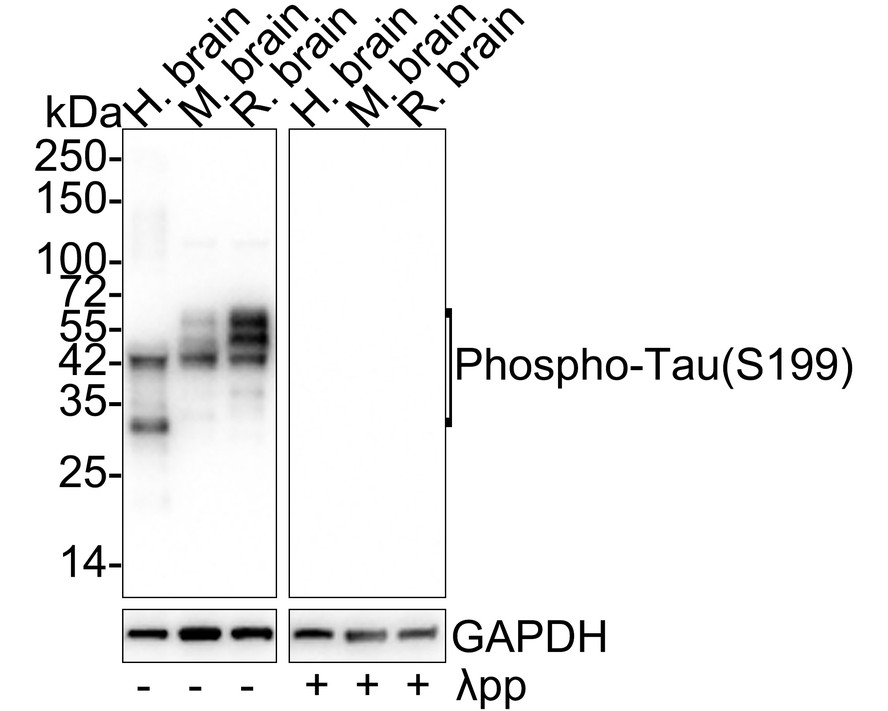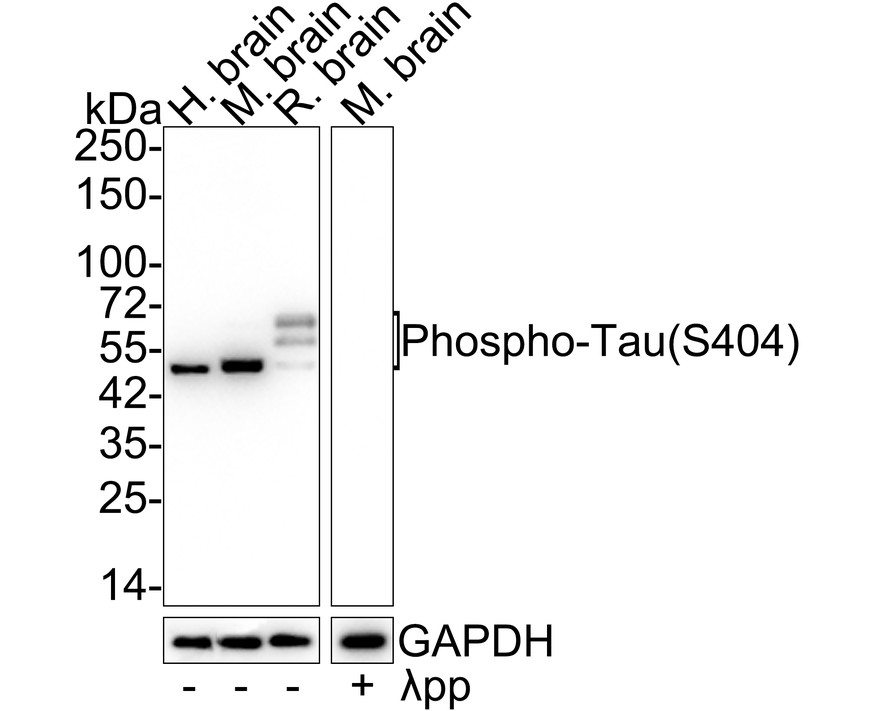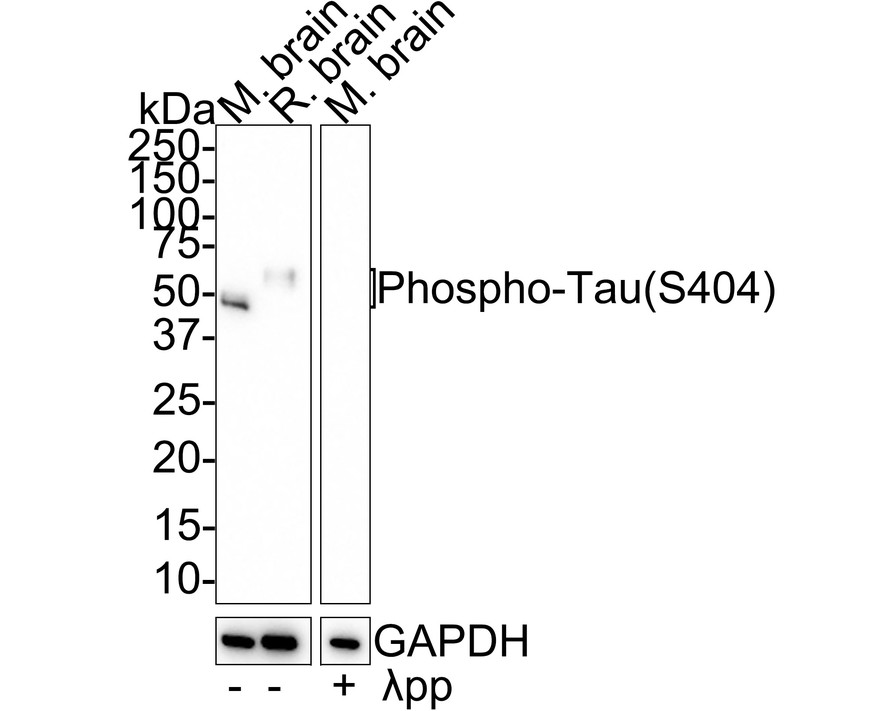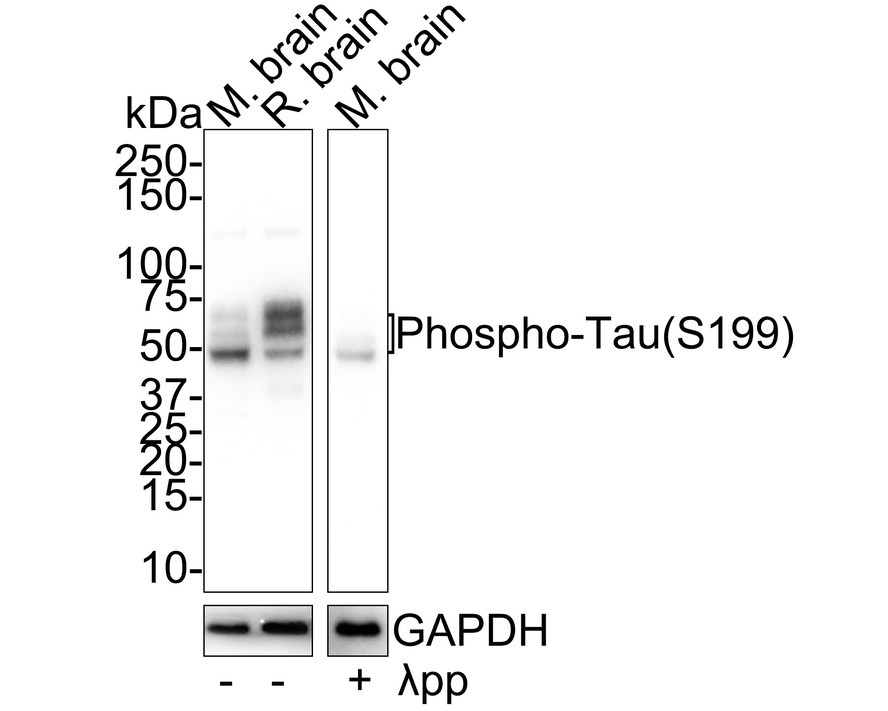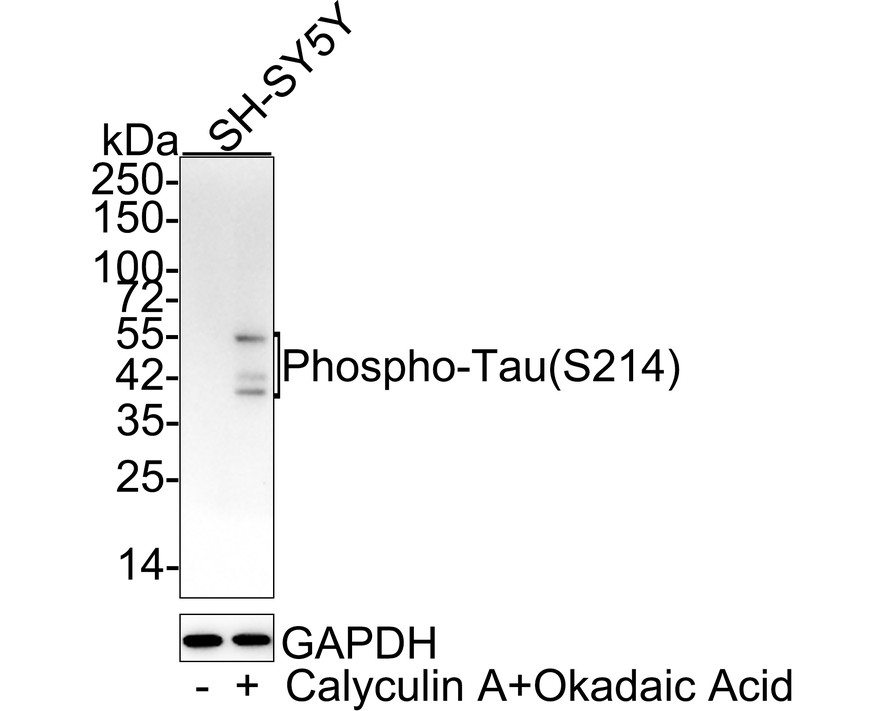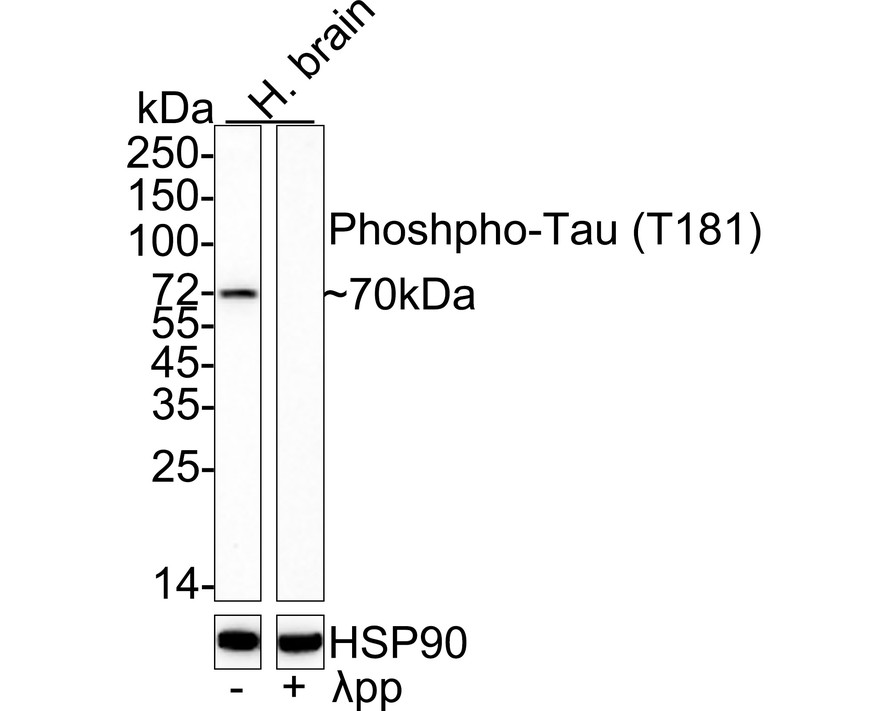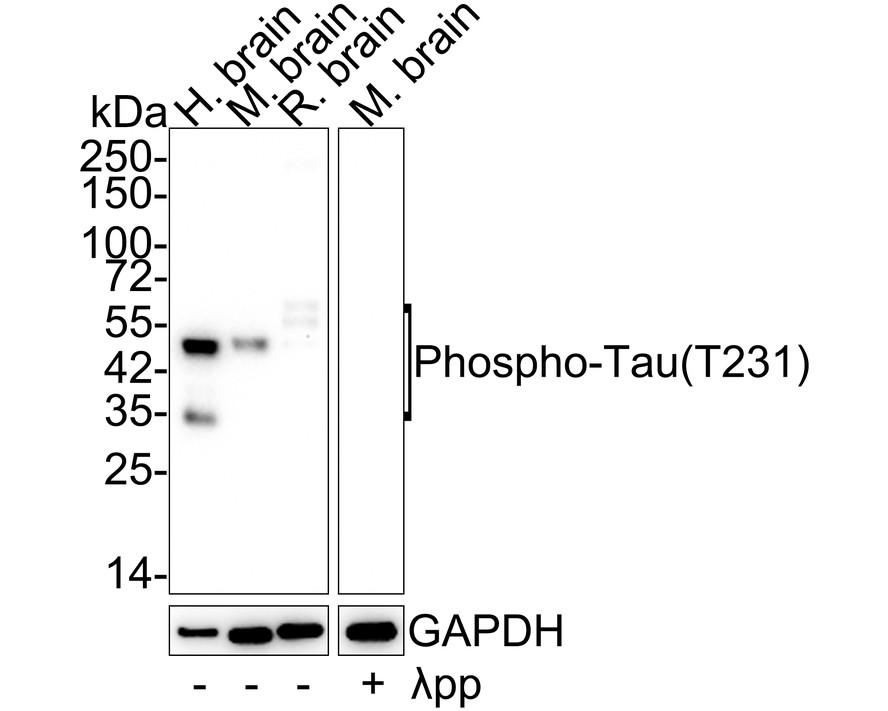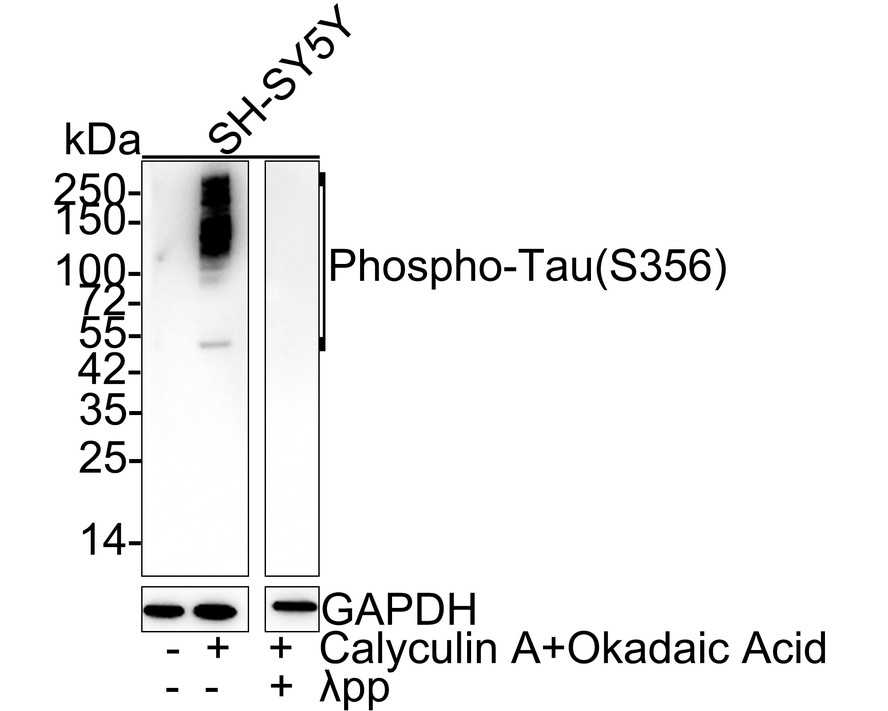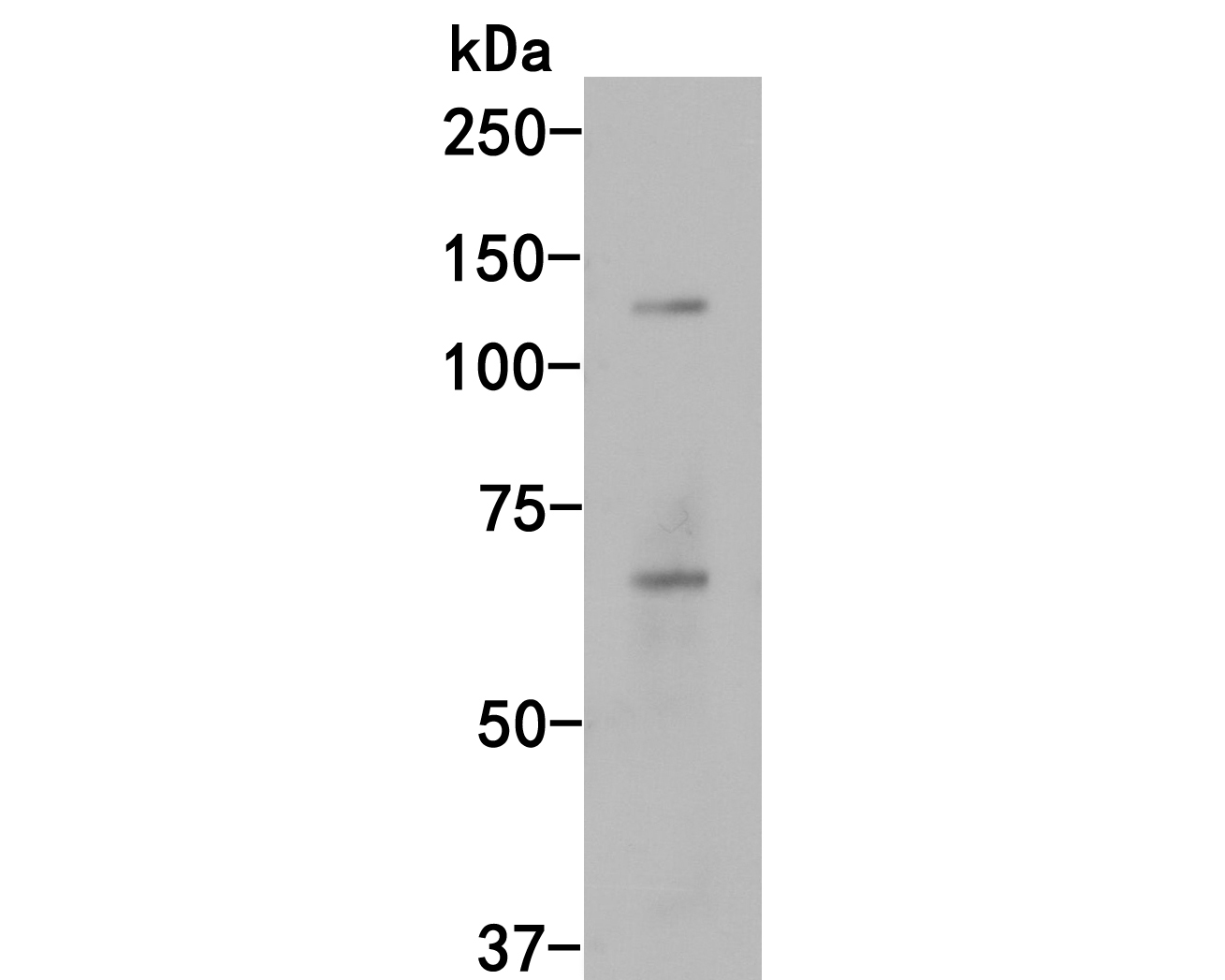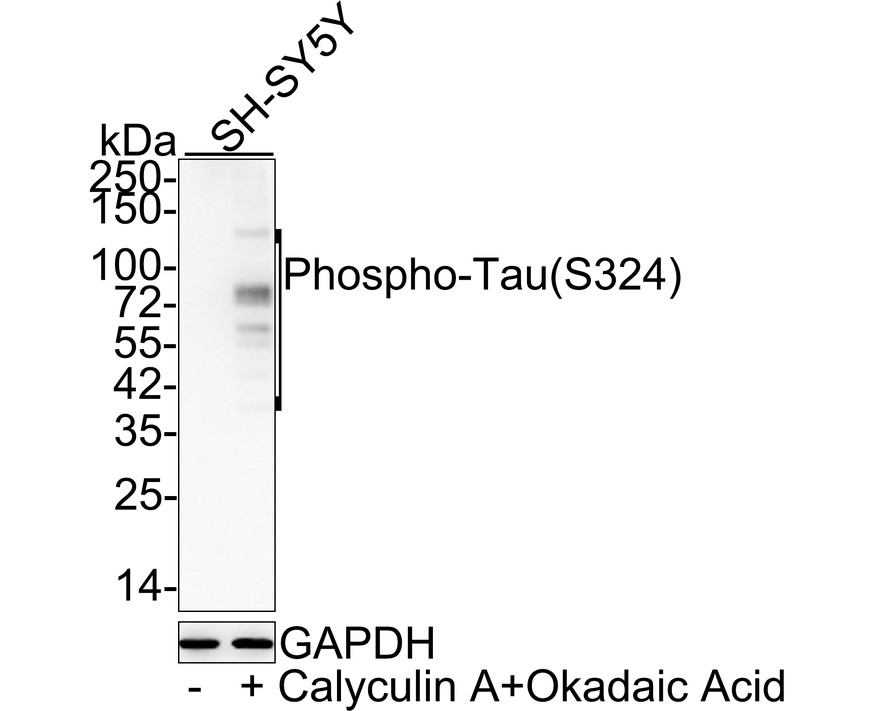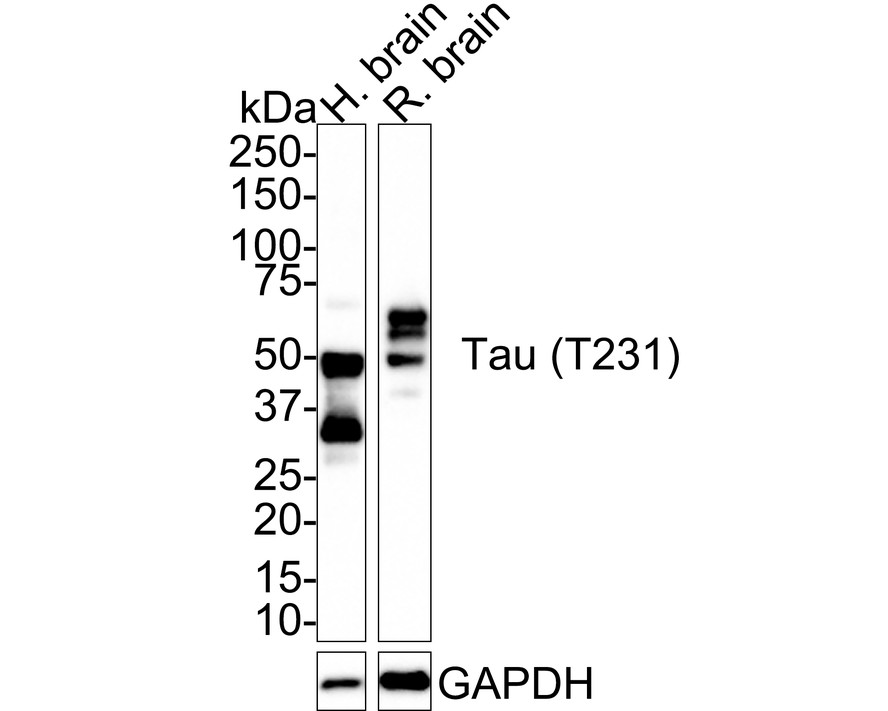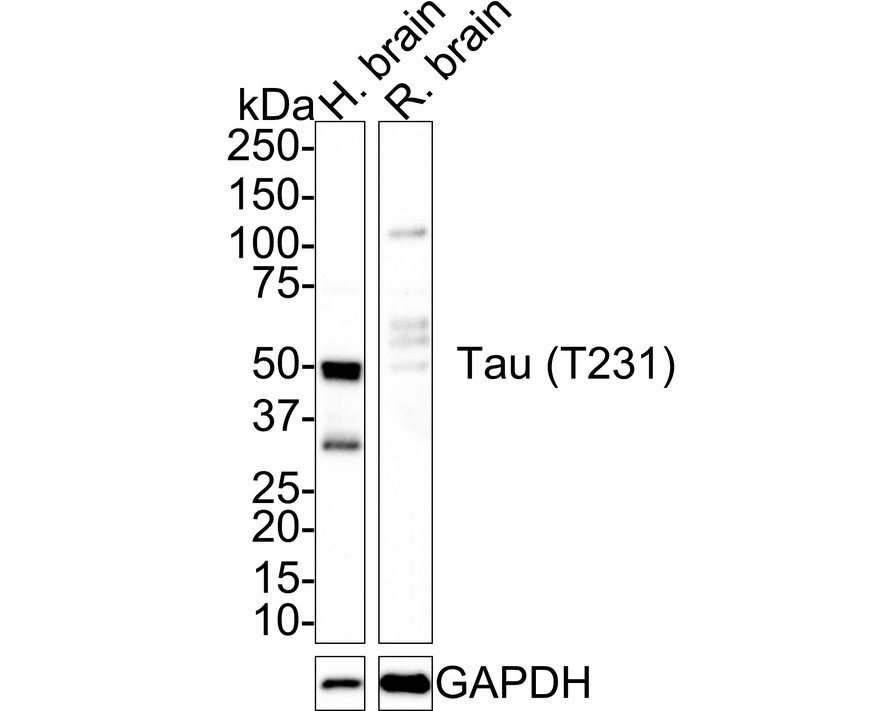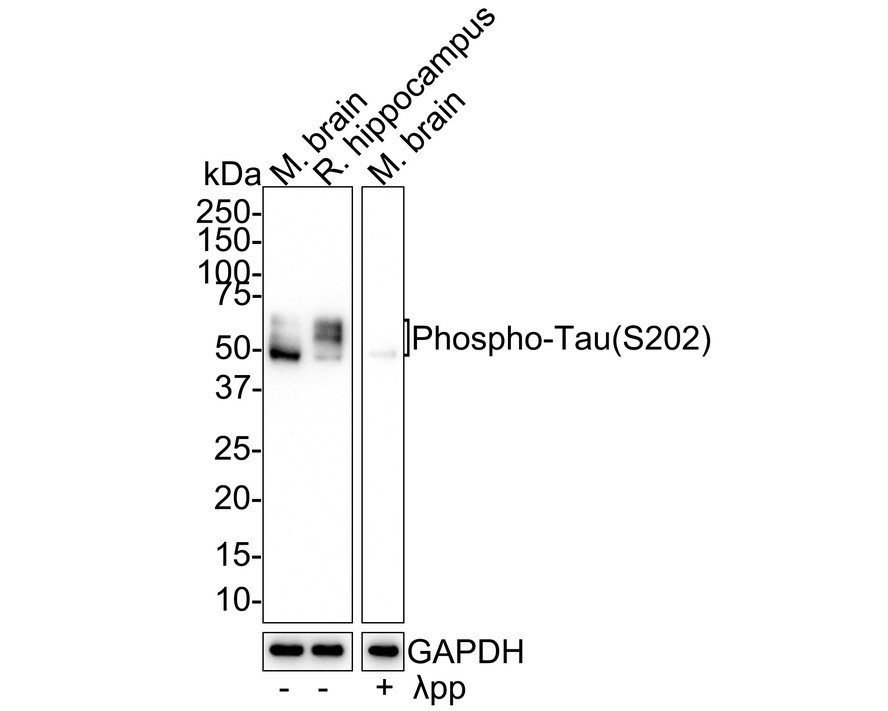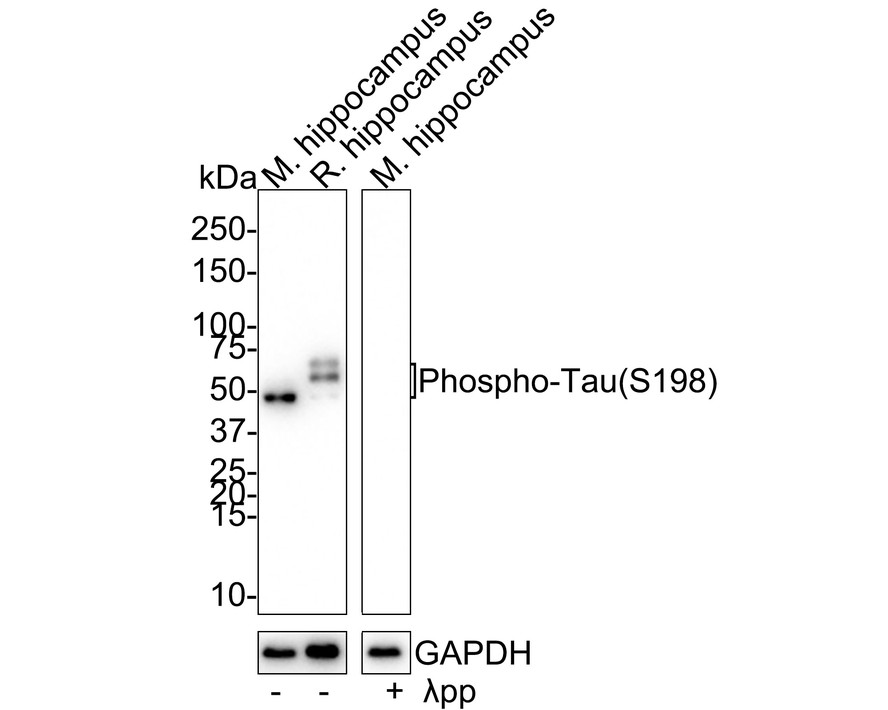概述
产品名称
Tau Rabbit Polyclonal Antibody
抗体类型
Rabbit Polyclonal Antibody
免疫原
Synthetic peptide within N-terminal human Tau.
种属反应性
Human, Mouse, Rat
验证应用
WB, IF-Cell, IHC-P
分子量
Predicted band size: 79 kDa
阳性对照
Human brain tissue lysate, mouse brain tissue lysate, mouse hippocampus tissue lysate, SHG-44, rat brain tissue, mouse brain tissue.
偶联
unconjugated
RRID
产品特性
形态
Liquid
浓度
1ug/ul
存放说明
Store at +4℃ after thawing. Aliquot store at -20℃. Avoid repeated freeze / thaw cycles.
存储缓冲液
1*PBS (pH7.4), 0.2% BSA, 40% Glycerol. Preservative: 0.05% Sodium Azide.
亚型
IgG
纯化方式
Immunogen affinity purified.
应用稀释度
-
WB
-
1:1,000-1:2,000
-
IF-Cell
-
1:50-1:200
-
IHC-P
-
1:50-1:200
靶点
功能
Tau protein is a highly soluble microtubule-associated protein (MAP). In humans, these proteins are found mostly in neurons compared to non-neuronal cells. One of tau's main functions is to modulate the stability of axonal microtubules. Other nervous system MAPs may perform similar functions, as suggested by tau knockout mice that did not show abnormalities in brain development - possibly because of compensation in tau deficiency by other MAPs. Six tau isoforms exist in human brain tissue, and they are distinguished by their number of binding domains. Three isoforms have three binding domains and the other three have four binding domains. Tau is a phosphoprotein with 79 potential Serine (Ser) and Threonine (Thr) phosphorylation sites on the longest tau isoform. Phosphorylation has been reported on approximately 30 of these sites in normal tau proteins. Hyperphosphorylation of the tau protein (tau inclusions, pTau) can result in the self-assembly of tangles of paired helical filaments and straight filaments, which are involved in the pathogenesis of Alzheimer's disease and other tauopathies.
背景文献
1. Yoshida H et al. Phosphorylation of microtubule-associated protein tau by AMPK-related kinases. J Neurochem 120:165-176 (2012).
2. Maas T et al. Interaction of tau with the neural membrane cortex is regulated by phosphorylation at sites that are modified in paired helical filaments. J Biol Chem 275:15733-15740 (2000).
组织特异性
Expressed in neurons. Isoform PNS-tau is expressed in the peripheral nervous system while the others are expressed in the central nervous system.
翻译后修饰
Phosphorylation at serine and threonine residues in S-P or T-P motifs by proline-directed protein kinases (PDPK1, CDK1, CDK5, GSK3, MAPK) (only 2-3 sites per protein in interphase, seven-fold increase in mitosis, and in the form associated with paired helical filaments (PHF-tau)), and at serine residues in K-X-G-S motifs by MAP/microtubule affinity-regulating kinase (MARK1, MARK2, MARK3 or MARK4), causing detachment from microtubules, and their disassembly. Phosphorylation decreases with age. Phosphorylation within tau/MAP's repeat domain or in flanking regions seems to reduce tau/MAP's interaction with, respectively, microtubules or plasma membrane components. Phosphorylation on Ser-610, Ser-622, Ser-641 and Ser-673 in several isoforms during mitosis. Phosphorylation at Ser-548 by GSK3B reduces ability to bind and stabilize microtubules. Phosphorylation at Ser-579 by BRSK1 and BRSK2 in neurons affects ability to bind microtubules and plays a role in neuron polarization. Phosphorylated at Ser-554, Ser-579, Ser-602, Ser-606 and Ser-669 by PHK. Phosphorylation at Ser-214 by SGK1 mediates microtubule depolymerization and neurite formation in hippocampal neurons. There is a reciprocal down-regulation of phosphorylation and O-GlcNAcylation. Phosphorylation on Ser-717 completely abolishes the O-GlcNAcylation on this site, while phosphorylation on Ser-713 and Ser-721 reduces glycosylation by a factor of 2 and 4 respectively. Phosphorylation on Ser-721 is reduced by about 41.5% by GlcNAcylation on Ser-717. Dephosphorylated at several serine and threonine residues by the serine/threonine phosphatase PPP5C.; Polyubiquitinated. Requires functional TRAF6 and may provoke SQSTM1-dependent degradation by the proteasome (By similarity). PHF-tau can be modified by three different forms of polyubiquitination. 'Lys-48'-linked polyubiquitination is the major form, 'Lys-6'-linked and 'Lys-11'-linked polyubiquitination also occur.; O-glycosylated. O-GlcNAcylation content is around 8.2%. There is reciprocal down-regulation of phosphorylation and O-GlcNAcylation. Phosphorylation on Ser-717 completely abolishes the O-GlcNAcylation on this site, while phosphorylation on Ser-713 and Ser-721 reduces O-GlcNAcylation by a factor of 2 and 4 respectively. O-GlcNAcylation on Ser-717 decreases the phosphorylation on Ser-721 by about 41.5%.; Glycation of PHF-tau, but not normal brain TAU/MAPT. Glycation is a non-enzymatic post-translational modification that involves a covalent linkage between a sugar and an amino group of a protein molecule forming ketoamine. Subsequent oxidation, fragmentation and/or cross-linking of ketoamine leads to the production of advanced glycation endproducts (AGES). Glycation may play a role in stabilizing PHF aggregation leading to tangle formation in AD.
亚细胞定位
Cytoplasm
别名
AI413597 antibody
AW045860 antibody
DDPAC antibody
FLJ31424 antibody
FTDP 17 antibody
G protein beta1/gamma2 subunit interacting factor 1 antibody
MAPT antibody
MAPTL antibody
MGC134287 antibody
MGC138549 antibody
展开AI413597 antibody
AW045860 antibody
DDPAC antibody
FLJ31424 antibody
FTDP 17 antibody
G protein beta1/gamma2 subunit interacting factor 1 antibody
MAPT antibody
MAPTL antibody
MGC134287 antibody
MGC138549 antibody
MGC156663 antibody
Microtubule associated protein tau antibody
Microtubule associated protein tau isoform 4 antibody
Microtubule-associated protein tau antibody
MSTD antibody
Mtapt antibody
MTBT1 antibody
MTBT2 antibody
Neurofibrillary tangle protein antibody
Paired helical filament tau antibody
Paired helical filament-tau antibody
PHF tau antibody
PHF-tau antibody
PPND antibody
PPP1R103 antibody
Protein phosphatase 1, regulatory subunit 103 antibody
pTau antibody
RNPTAU antibody
TAU antibody
TAU_HUMAN antibody
Tauopathy and respiratory failure, included antibody
折叠图片
-
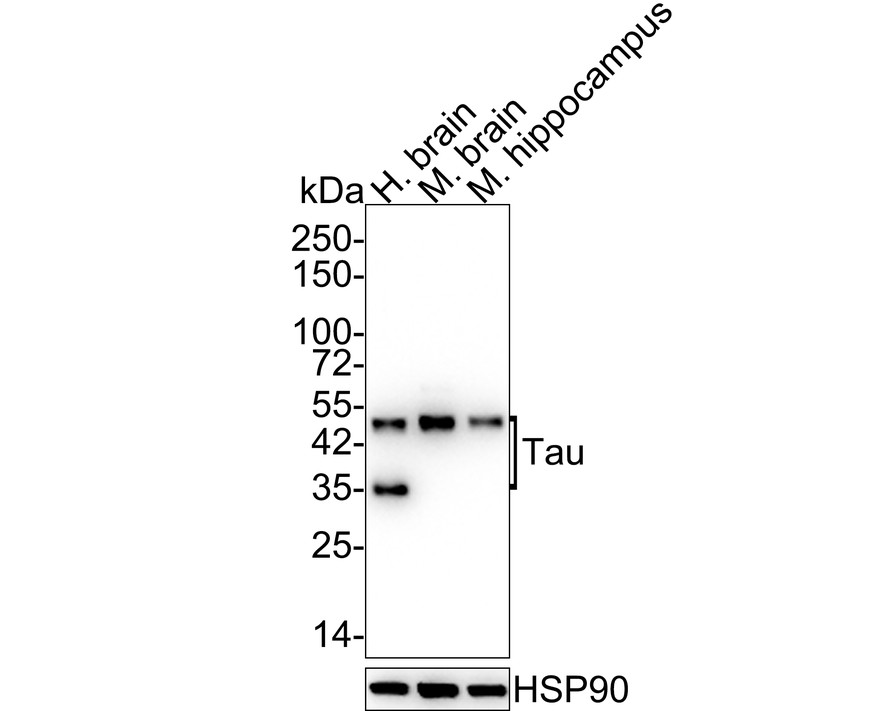
Western blot analysis of Tau on different lysates with Rabbit anti-Tau antibody (R1401-7) at 1/1,000 dilution.
Lane 1: Human brain tissue lysate
Lane 2: Mouse brain tissue lysate
Lane 3: Mouse hippocampus tissue lysate
Lysates/proteins at 20 µg/Lane.
Predicted band size: 79 kDa
Observed band size: 35-50 kDa
Exposure time: 1 minute 55 seconds;
4-20% SDS-PAGE gel.
Proteins were transferred to a PVDF membrane and blocked with 5% NFDM/TBST for 1 hour at room temperature. The primary antibody (R1401-7) at 1/1,000 dilution was used in 5% NFDM/TBST at 4℃ overnight. Goat Anti-Rabbit IgG - HRP Secondary Antibody (HA1001) at 1/50,000 dilution was used for 1 hour at room temperature. -

ICC staining Tau in SHG-44 cells (green). The nuclear counter stain is DAPI (blue). Cells were fixed in paraformaldehyde, permeabilised with 0.25% Triton X100/PBS.
-

Immunohistochemical analysis of paraffin-embedded rat brain tissue using anti-Tau antibody. Counter stained with hematoxylin.
-

Immunohistochemical analysis of paraffin-embedded mouse brain tissue using anti-Tau antibody. Counter stained with hematoxylin.
Please note: All products are "FOR RESEARCH USE ONLY AND ARE NOT INTENDED FOR DIAGNOSTIC OR THERAPEUTIC USE"
Alternative Products
Tau Recombinant Rabbit Monoclonal Antibody [SZ03-03]
Application: WB,IHC-P,IP,IHC-Fr
Reactivity: Human,Mouse,Rat
Conjugate: unconjugated
Tau Recombinant Rabbit Monoclonal Antibody [SD205-09]
Application: WB,IF-Cell,IF-Tissue,IHC-P,FC,IHC-Fr
Reactivity: Human,Mouse,Rat
Conjugate: unconjugated
同靶点&同通路的产品
Phospho-Tau (S199) Recombinant Rabbit Monoclonal Antibody [JE46-95]
Application: WB
Reactivity: Human,Mouse,Rat
Conjugate: unconjugated
Phospho-Tau (S404) Recombinant Rabbit Monoclonal Antibody [JE47-88]
Application: WB,IHC-P
Reactivity: Human,Mouse,Rat
Conjugate: unconjugated
Phospho-Tau (S404) Recombinant Rabbit Monoclonal Antibody [JE66-82]
Application: WB,IHC
Reactivity: Human,Mouse,Rat
Conjugate: unconjugated
Phospho-Tau (S199) Recombinant Rabbit Monoclonal Antibody [JE66-80]
Application: WB
Reactivity: Human,Mouse,Rat
Conjugate: unconjugated
Phospho-Tau (S214) Recombinant Rabbit Monoclonal Antibody [JE66-83]
Application: WB
Reactivity: Human,Mouse,Rat
Conjugate: unconjugated
Phospho-Tau (T181) Recombinant Rabbit Monoclonal Antibody [PSH05-42]
Application: WB,IHC-P
Reactivity: Human,Mouse
Conjugate: unconjugated
Tau Recombinant Rabbit Monoclonal Antibody [SZ03-03]
Application: WB,IHC-P,IP,IHC-Fr
Reactivity: Human,Mouse,Rat
Conjugate: unconjugated
Phospho-Tau (T231) Recombinant Rabbit Monoclonal Antibody [SC58-08]
Application: WB,IHC-P,IP,IF-Tissue,IHC-Fr
Reactivity: Human,Mouse,Rat
Conjugate: unconjugated
Tau Recombinant Rabbit Monoclonal Antibody [SD205-09]
Application: WB,IF-Cell,IF-Tissue,IHC-P,FC,IHC-Fr
Reactivity: Human,Mouse,Rat
Conjugate: unconjugated
Phospho-Tau (S356) Recombinant Rabbit Monoclonal Antibody [JE46-86]
Application: WB
Reactivity: Human,Mouse,Rat
Conjugate: unconjugated
Phospho-Tau (S396) Recombinant Rabbit Monoclonal Antibody [SN62-09]
Application: WB,IF-Cell,IF-Tissue,IHC-P,IHC-Fr
Reactivity: Mouse,Rat,Human
Conjugate: unconjugated
Phospho-Tau (S324) Recombinant Rabbit Monoclonal Antibody [JE30-73]
Application: WB
Reactivity: Human,Mouse,Rat
Conjugate: unconjugated
Phospho-Tau (T231) Recombinant Rabbit Monoclonal Antibody [PSH01-05]
Application: WB,IHC-P
Reactivity: Human,Mouse,Rat
Conjugate: unconjugated
Phospho-Tau (T231) Recombinant Rabbit Monoclonal Antibody [PSH01-04]
Application: WB,IHC-P,IF-Tissue
Reactivity: Human,Mouse,Rat
Conjugate: unconjugated
Phospho-Tau (S202) Recombinant Rabbit Monoclonal Antibody [JE66-81]
Application: WB
Reactivity: Human,Mouse,Rat
Conjugate: unconjugated
Phospho-Tau (S198) Recombinant Rabbit Monoclonal Antibody [JE66-79]
Application: WB
Reactivity: Human,Mouse,Rat
Conjugate: unconjugated





